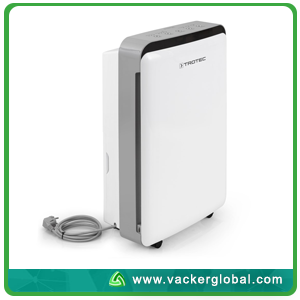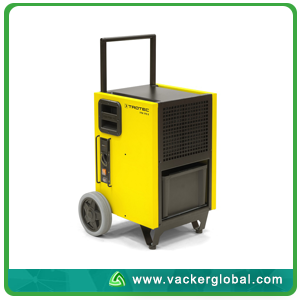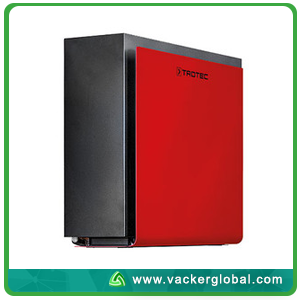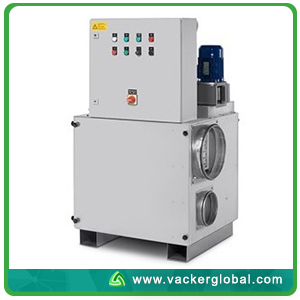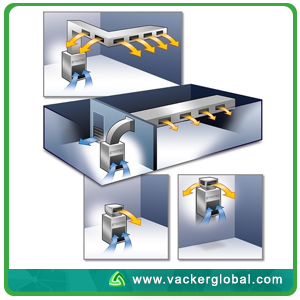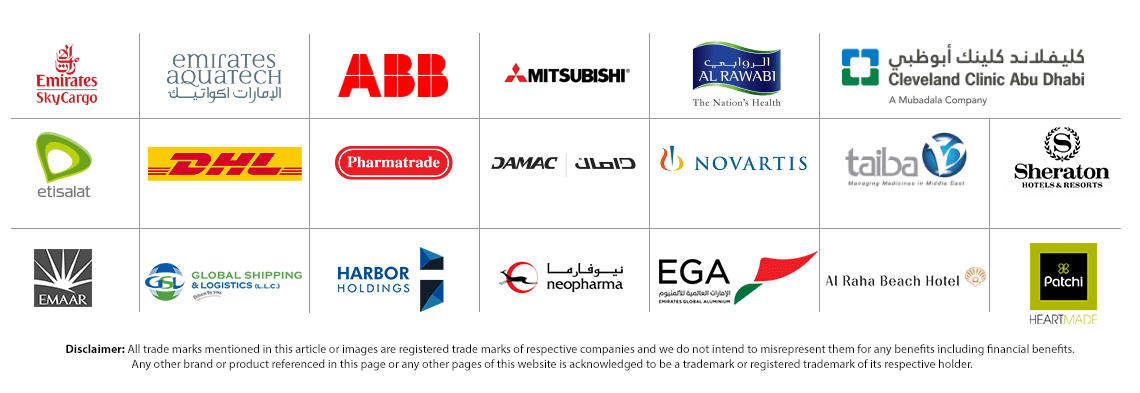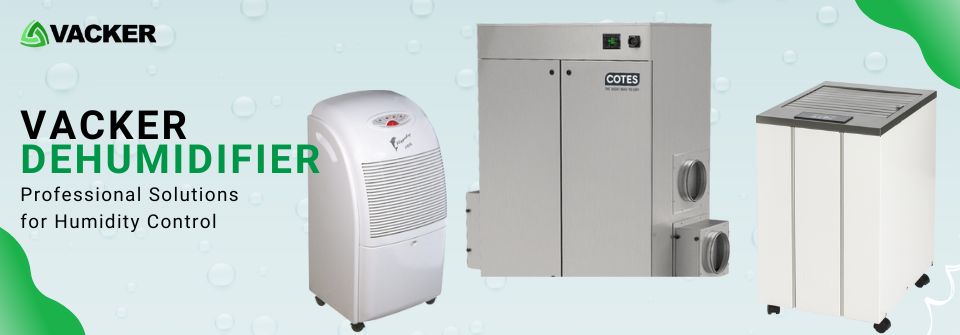 We are supplying various types of industrial and commercial dehumidifiers and air dryers in UAE, Saudi Arabia, Qatar, Oman, Bahrain, Kuwait, Jordan etc. Also, we supply these dehumidifiers across the entire African continent.
We are supplying various types of industrial and commercial dehumidifiers and air dryers in UAE, Saudi Arabia, Qatar, Oman, Bahrain, Kuwait, Jordan etc. Also, we supply these dehumidifiers across the entire African continent.
What is a dehumidifier?
A dehumidifier is an electrical appliance which reduces the humidity level in the air. By continuous operation, it keeps a constant level of humidity in the air. Keeping the correct humidity level is essential for human comfort. Also, it helps in reducing mould. In commercial applications, many product storages require specific humidity levels. Dehumidifiers help to maintain these levels. The basic operation principle is by extricating water from the air. Different models based on capacity and technology are available for residential and commercial usage. Warehouses and commercial buildings will require very large dehumidifiers. Also, indoor ice rinks and swimming pools generate very high levels of humidity. They require dehumidifiers of high capacity. Just like an air conditioner controls the air temperature in a room, a dehumidifier controls the humidity in the air. This process is known as dehumidification.
How to select a Dehumidifier?
There is a wide range of dehumidifiers from various manufacturers. You may follow these guidelines:
- Identify your desired humidity levels based on the applications of the area. You can see a guideline of recommended humidity levels.
- Check your current humidity levels using a hygrometer. If it is a home, you may not need to go into these details and may select one of these models.
- Take the measurement of the room.
- You should know the current temperature levels for the calculation.
- Use our free software to calculate the required dehumidification capacity.
- For applications above 10°C, select a condensation type dehumidifier.
- For applications below 10°C, select a desiccant type dehumidifier.
These are broad steps for selecting a dehumidifier. Please check with us before your final decision.
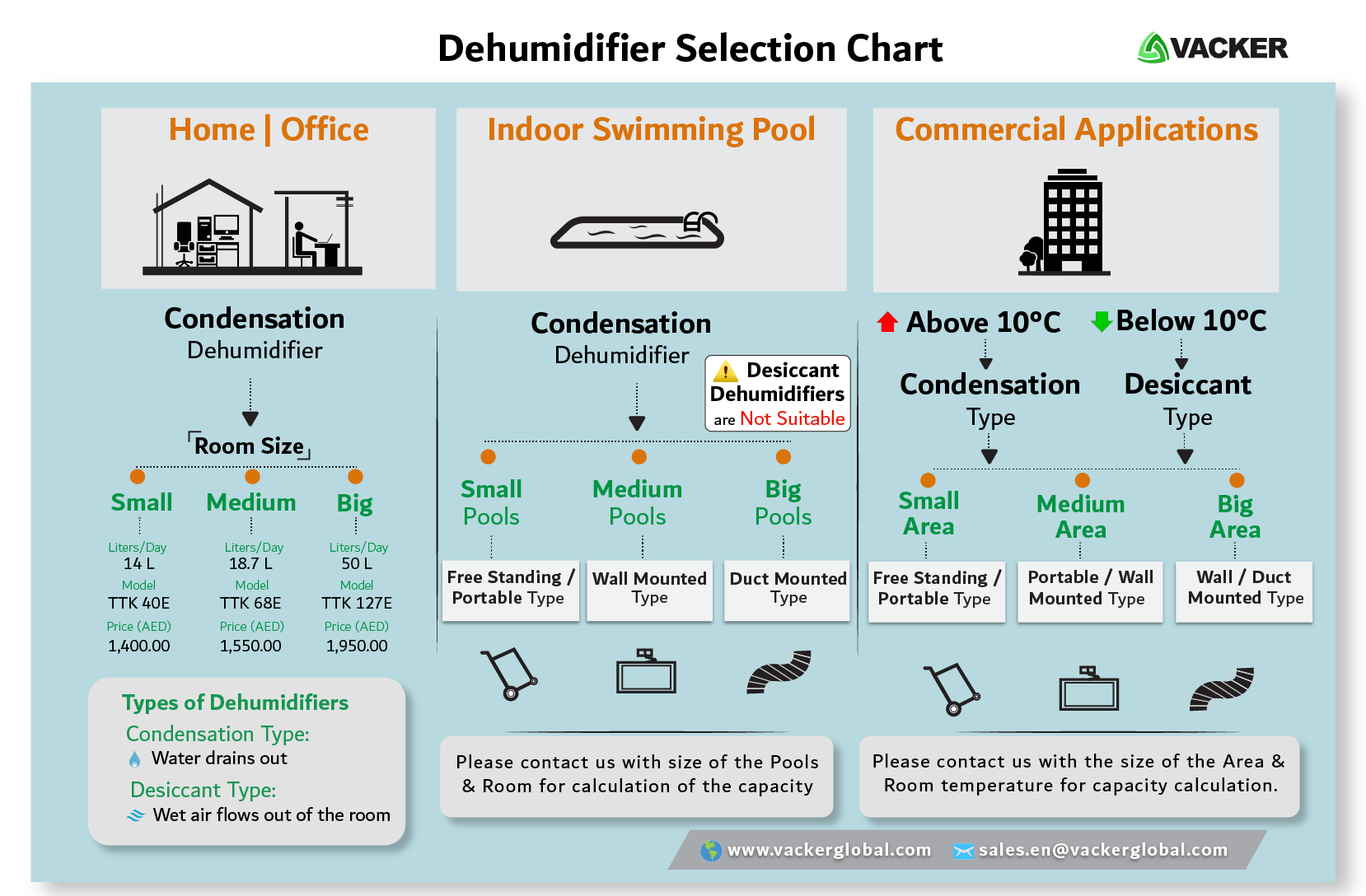
Advantages Of Dehumidifier
Dubai does not experience high humidity the whole year. However, its summers are very hot and humid. September is by far the most humid month with humidity levels reaching as high as 90%.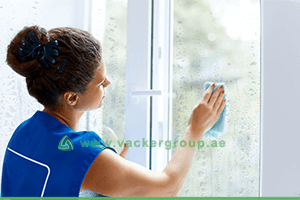 There are two main reasons to explain the atrociously high levels of humidity in Dubai. The first one is that the country is located within the Northern desert belt which is mainly characterised by arid subtropical climate. The second one is the presence of the sea. If the wind blows from the coast, it usually gets very humid. Also, there can be heavy fog. These factors contribute to the unusually high levels of humidity in Dubai.
There are two main reasons to explain the atrociously high levels of humidity in Dubai. The first one is that the country is located within the Northern desert belt which is mainly characterised by arid subtropical climate. The second one is the presence of the sea. If the wind blows from the coast, it usually gets very humid. Also, there can be heavy fog. These factors contribute to the unusually high levels of humidity in Dubai.
As you can see, the humidity situation in Dubai tends to be generally high given that the city is located on the coast. High humidity has several disadvantages. These include the following:
-
Prevents formation of bacteria, mites, mould and mildew
High humidity, especially in the summer months, provides favourable conditions that encourage mould formation and thriving of mites at a very rapid rate. Since mould, mites, and mildew require a constant supply of moisture to survive, you can expect to suffer from this problem. A dehumidifier is important as it reduces the moisture in the air and hence helps you control mould and dust mite formation.
-
Prevent yourself from health issues
High humidity is associated with a raft of health issues because it is the main cause of bacteria formation. High humidity can lead to sleeping disorders, respiration problems, burning of eyes, throat, and nose, asthma and allergies brought about by mould spores. The perfect solution for this problem is investing in a dehumidifier that has an efficient filter.
-
Prevents potential damage to your property
If the air contains too much water, it will condense on cooler surfaces like walls and window glasses. If this water is left to stay on your walls and windows, it poses a real danger of damage to your property. It can also damage your painting, important file records or valuable books and other properties.
-
Damage to electronic equipment
If you have expensive electronic equipment like Flat Screen TV, home theatre or cameras, they are at the risk of being damaged by high humidity. High humidity in homes leads to water condensing on PCBs of electronic gadgets or even rusting of PCB. By installing a dehumidifier, you could stop your electronic gadgets from being terribly destroyed.
-
Damage to carpets and clothing and bad smell
It is not uncommon to visit a posh house and then be met with a bad smell. The bad smell is brought about by high humidity. High humidity can also damage expensive clothing items and your carpet.
So what would you prefer? Purchasing a dehumidifier or putting your household property and building at risk? The simple solution to all the above problems is to invest in a dehumidifier. As you can see, there are many reasons to invest in a dehumidifier.
How dehumidifiers reduce the humidity in a home?
As beautiful as Dubai is, humidity and heat can be a nightmare. At such times the only solution might be to go indoors to your cooled room. But what if you have to deal with humidity problem outdoors and indoors? To put it simply, that’s just plain torture. In this section, we tell you the top three things to do to reduce humidity in your Dubai home.
-
Improve Your Home’s Air Circulation
If air is properly circulated in the room, it can dramatically reduce humidity in your home. A room without proper circulation feels stuffy and there is a feeling as if the air is stagnant. This usually leads air to become denser and a rise in humidity.
To improve circulation, use ceiling fans and where necessary, extra floor fans and box fans. Properly circulated air in the room dries out and reduces the humidity. This makes them cooler and comfortable. Ensure ceiling fans are rotating properly for the season. During summer, the proper way for fans to rotate is counterclockwise. During winter, you should reverse rotating direction so that cooler air is pulled up, while warmer air is rotated around the room.
-
Take advantage of kitchen and bathroom exhaust fans
Ventilation fans in your bathroom and kitchen are usually used to reduce bad smells in these rooms. The rooms tend to produce a lot of moisture and lack of ventilation quickly leads to mould growth.
Use the vents in these rooms to reduce excessive humidity and the rooms will be safer and even more comfortable. Ensure that these vents are not stopped or blocked in any way. Always ensure that the vents are kept clean and don’t have any debris and dust.
-
Preventive Maintenance
Preventive maintenance can go a long way in ensuring proper levels of humidity in your home. Always make sure that you schedule regular maintenance on the major units in your homes like hot water system and HVAC systems as this will ensure long life and efficiency.
-
Periodic checks
Also, you can perform the following preventive measures to reduce humidity in your Dubai home:
- Watch out for any leaks in your ceiling.
- Check seals and replace weather stripping and caulk around windows and doors which can let in hot and humid air
- Inspect your air ducts for moisture and ensure that they are properly insulated
-
Reduce the overall moisture in your home
A dehumidifier is the surest and the most efficient way to check the humidity in the rooms of your home. If only certain places in your home experience high humidity, a basic dehumidifier might help. However, if you have humidity in the whole of your house, you may want to buy a whole-house unit. A dehumidifier is not part of your AC system and can be run independently of your AC unit. It can also operate on days with high humidity but temperatures are reasonable. A dehumidifier combined with your air conditioning unit will dramatically improve the moisture-removing capability of the units.
-
Reduce evaporation
Using less water for shower is another way to decrease moisture in your home. When bathing, ensure you take shorter and cooler showers as this will reduce the amount of steam in the bathroom.
-
Watering the plants
Removing houseplants also a good way of reducing humidity in the house. This is because plants usually release moisture in the air and if you have lots of houseplants, they could be the reason for the high humidity in the house. You can either put these plants outside during the humid months or have them concentrated in one room.
Applications of dehumidifiers
A dehumidifier is used for various residential, commercial and industrial purposes. While a rise in temperature is noticed immediately, a rise in humidity gets unnoticed and will cause adverse effects in the long term. Some of the wide areas where high-quality dehumidifiers find their applications include the following.
-
Health
Humidity in the air results in a damp environment which is a breeding ground for fungus and insects such as moths, and fleas which require damp environments to breed. In certain cases, the humidity in the air leads to respiratory and perspiration issues in the human body. Dehumidification of air keeps the health issues away and the environment free from pests.
-
Lifestyle
A humid climate is extremely uncomfortable as it causes excessive sweat and perspiration of fluids from the human body leading to dehydration and nausea. The precipitation levels of the body vary due to moisture leading to fatigue quickly.
While human lifestyle becomes uncomfortable due to the humidity in the air, it also causes issues in material objects such as pipes and grills to rust. These get rusted more quickly due to the moisture in the air. This results in frequent maintenance of iron ducts and pipes. A high-quality dehumidifier helps in comforting the human lifestyle. Also, it reduces the cost of repair and maintenance of households by removing the humidity in the air.
-
Industrial Uses
High-quality Dehumidifiers are widely used in industrial environments to maintain a certain level of humidity to create a conducive environment to produce or manufacture humidity-sensitive products. eg. ferrous materials are prone to rusting due to humidity and hence steel storage areas should have controlled humidity. Dehumidification of air is essential in such environments.
Types of Dehumidifiers
We will explain based on technology and also based on the applications.
-
Types of High-quality Dehumidifiers based on technology
Based on the technology, there are two types as listed here:
-
Condensation dehumidifiers
These are the most commonly used dehumidifiers that usually work like a refrigerator by drawing moist air. Thereafter evaporating the moisture in the air over a condensing coil, thus removing the water. The dry air is released back into the environment.
These types of dehumidifiers suit normal room temperature environments (above 10°C). The condenser coil is at an optimal temperature above 10°C. However, in colder climates, this becomes less effective. The water is collected in a tray in the machine or can be drained out through a drainage pipe. Read more on Condensation Dehumidifiers.
-
Desiccant Dehumidifiers
These dehumidifiers suck the air and pass them over a material that absorbs the moisture in the air. The desiccant material is usually silica gel. This is the most natural disinfectant that we commonly find in shipped electronic goods. They don’t condense the air over the coil and hence, they are ideal for colder climates. The wet air is taken through the inlet and the moisture content is absorbed by the desiccant. The outlet air will be dry which is recirculated in the room. Read more on Desiccant Dehumidifiers.
-
-
Sub-categories of Dehumidifiers based on applications
The major sub-categories as listed in the subsequent pages are listed below:
-
Adsorption & Desiccant dehumidifiers
These dehumidifiers use adsorption technology to reduce humidity. desiccant rotors are used to absorb humidity and hence these are also known as rotor dehumidifiers. Please read more on Adsorption and Desiccant dehumidifiers.
-
Air dryers
Portable home type dehumidifiers are known as air dryers. These come in different sizes and shapes based on design and capacity requirements. Read more on Air Dryers.
-
Portable Dehumidifiers for home and office
These are smaller in size as its name says. They are lightweight and can be carried easily and are relatively cheap. They are very effective for smaller spaces and they are mostly condensation types. They typically use a coolant to cool the surface by condensing the air into water vapour. They work on the principle of condensation and they operate with very little noise. Read More about Portable Dehumidifiers
-
Basement Dehumidifiers
The basement of houses and buildings will have a high concentration of moisture in the air. These require special basement dehumidifiers to eliminate humidity. Read more about Basement Dehumidifiers.
-
Marine & Boat Dehumidifiers
In marine conditions, humidity is extremely high and uncontrollable. The goods transported in a ship may have to be kept under moisture-less conditions. This will require the usage of high-quality dehumidifiers. Special high capacity dehumidifiers are required under such conditions. Read more about Marine and Boat dehumidifiers.
-
Commercial Dehumidifiers
As the name suggests, these are for industrial applications and are rugged in nature. Both movable and stationary models are available in varying capacity for dehumidification of air. Read More about Commercial Dehumidifiers
-
Dehumidifiers and air dryers for construction worksites
Construction sites are open areas and will have high humidity based on ambient conditions. However excessive humidity is harmful to the people working at construction sites. In order to reduce the high humidity in such areas, you may use high capacity dehumidifiers. Please read more on dehumidifiers and air dryers for construction worksites.
-
Dehumidifier capacity calculation
In order to calculate the capacity of the dehumidifier to suit your needs, please use our free software for dehumidifier capacity calculation.
-
Cold room Dehumidifiers for chillers, walk-in freezers
These are usually industrial high-quality dehumidifiers which are heavy duty. These can withstand lower climatic conditions. Desiccant types are used under these conditions and come in a huge variety of dehumidification capacity ranging from 0.35 kg/h to 58 kg/h. These are for dehumidification of air during storage of medicines, vaccines, fruit and vegetables such as banana, onion, potato etc. Read More about Cold Room Dehumidifier
-
Dehumidifiers for Data Center & Server rooms
Data centres and server rooms will generate high humidity because the temperature will be at a low level to cool down all the systems. If the humidity is high, condensation can happen on electronic components and will slowly cause damage. In order to avoid this, dehumidifiers are required in Data centres & server rooms. Read more about Data Center and Server room dehumidifiers.
-
Dehumidifiers for libraries and document storage
All kind of libraries and document archival areas require a high level of humidity control. Humidity can cause irreparable damage to these stored books and documents. In order to reduce humidity, you need to use dehumidifiers. Please read more on dehumidifiers suitable for libraries and document archival storage areas.
-
Dehumidifiers for Museums and Art Galleries
Museums and art galleries require very precise humidity control. High or low humidity destroys artefacts, paintings, etc. Hence ideally a combination of dehumidifiers and humidifiers are required for all such areas. Read more on Dehumidifiers for Museum and Art Galleries.
-
Dehumidifiers for the painting process
In order to ensure high-quality painting finish, the surroundings have to be adequately dry. Else the quality and life of the painting will not be good. Special types of dehumidifiers are required for this process. Please read more on dehumidifiers for the painting process.
-
Dehumidifiers for the pharmaceutical warehouse & medicine storage
Various types of medicines and vaccines need to be stored under controlled conditions of humidity in warehouses, cold rooms etc. In such conditions, a dehumidifier is required to reduce the humidity levels. For medicine warehouses, generally, the requirement is to keep the humidity under 60-65% RH. Please read more on our dehumidifiers for pharma warehouses.
-
Dehumidifier reviews and comparison
In order to find comparison and reviews of various types of dehumidifiers, please see our detailed page of reviews and comparison of dehumidifiers.
-
Duct mounted Dehumidifiers
In bigger installations, portable dehumidifiers may not be enough in terms of capacity. In such cases, duct mounted dehumidifiers are required. The dehumidifiers are connected to the air ducts and the air is processed for humidity control. Read more on Duct mounted dehumidifiers.
-
Industrial Dehumidifiers
Industrial heavy-duty dehumidifiers are for industrial and continuous applications. The uses include construction sites, factories etc. These are stationary type dehumidifiers. Read more on industrial dehumidifiers.
-
High Temperature, Process drying dehumidifiers
Many of the high-temperature process industries require humidity control. The challenge is that most of the dehumidifiers will not work efficiently in high-temperature areas. We supply special types of dehumidifiers capable of withstanding high temperatures. Please read more on dehumidifiers for high temperature, process industries.
-
Refrigerant dehumidifiers
Refrigerant dehumidifiers are sane as condensation dehumidifiers. A refrigerant is used to cool down the air to condense water. Hence we call them as Refrigerant dehumidifiers also. Please read more on our Refrigerant dehumidifiers.
-
Swimming Pool & Spa Dehumidifiers
As you can imagine swimming pools huge amount of humidity. This will cause extensive damage to the surrounding areas if left uncontrolled. The temperature of the water is different from the temperature of the surrounding. This temperature difference also causes excessive moisture. For this reason, all indoor swimming pools need to have a strong capacity for dehumidification of air, which is capable of working continuously. Read More about Swimming Pool and Spa Dehumidifiers
-
Wall-mounted dehumidifiers
In aesthetic interiors, you may want nice looking dehumidifiers. For such areas, we supply wall mounted dehumidifiers. There will be an internal unit and an external unit. Also, we have models where the internal and external models are combined into a single wall mounted dehumidifier. Please read more about wall-mounted dehumidifiers.
-
Warehouse Dehumidifiers
Warehouses need to have controlled humidity. This is especially true when you are storing items such as medicines, fruits, vegetables, tobacco etc. Depending on the size of the warehouse, the capacity has to be decided. Normally condensation types are used for temperature above 10°C. We have models with dehumidification capacity ranging from 22 litres/day to 520 litres/day Read More about Warehouse Dehumidifier
-
Dehumidifiers for water leak and Flood Damage restoration
Water leak and flood cause huge damage to interiors. And we have to quickly remove the water from the interiors to minimize the damage. The damage can be on the walls, on the floor etc. Inorder to do that, we have to make the atmosphere extremely dry. When the atmosphere becomes extremely dry, the moisture stored in walls, floor etc gets into the dry air. By continuing this process we can dry the affected areas. Please read more on our dehumidifiers for water leak and Flood Damage restoration.
-
Before you buy a dehumidifier, there are certain things that you need to consider first. In this section, we look at some of the most important factors to put into consideration when buying a Dehumidifier.
Working Principle of a Dehumidifier
A condensation dehumidifier works by extracting water from the air, thus keeping the air dry around its environment. The fan in the dehumidifier collects air by sucking it in. The cold coils of the dehumidifier condense air to extract the moisture from it. This water goes into a drain or inbuilt water tank. Thus the air going out of the dehumidifier will be dry compared to the air intake. Thus in dehumidification, wet air is sucked in and dry is air is exhausted.
Every high-quality dehumidifier has a humidity control to regulate and operate at its optimal specification. Thy hygrostat is similar to a thermostat in operations. You can set the humidity levels that you require inside the area. Once a level is set, the dehumidifier will automatically shut off the dehumidification of air once the value is reached.
If there is no hygrostat, the machine will work continuously. For huge areas and construction sites, machines are operated without hygrostat. However, for indoor applications, there will be a hygrostat.
For a living area, the maximum comfortable humidity will be around 65-70%RH. If you have a respiratory problem or you have allergies, you will especially feel uncomfortable above this range. Also, wet air deposits itself onto the walls and cause formation of mould and fungi. Too much humidity can lead to mould growth, dust mite, and fungus. A high level of humidity also attracts unwanted insects like centipedes, spiders, and millipedes who all thrive in moist environments. With the help of a dehumidifier, you can stop this from happening.
Desiccant Dehumidifier – These type is also known as adsorption type dehumidifiers. The technology used in these models is absorbing the moisture content using an adsorbent such as silica gel.
Dehumidifier capacity calculation
For every room, you need to calculate the capacity of the required dehumidifier to achieve a certain humidity level. Please see our dehumidifier capacity calculation software for all your design purposes.
Do I need special features?
Different models of dehumidifiers come with specific features. You should find out if these features i.e option of ducting will be useful to you. The majority of models allow for ducting to enable you to dehumidify several spaces at ago. Ducting also allows you to hide the unit in a closet or even a separate room. Remote controls, humidistats, integrated timers, digital controls, internal condensate pumps and caster wheels/handles for easy mobility are other special features.
We have mentioned internal condensate pumps, ducting, as well as several other features for most of our models.
Vacker supplies all kinds of dehumidifiers throughout the Middle East and African countries.
![]()
In the Middle East, we serve the United Arab Emirates, Kingdom of Saudi Arabia, Oman, Qatar, Bahrain, Iraq, Lebanon, Egypt, Jordan, Libya, Tunisia, etc.
In Africa, we serve countries including Kenya, Algeria, Tanzania, Djibouti, Chad, Ghana, Rwanda, Uganda, Nigeria, Ethiopia, Morocco, Angola, South Africa, etc.
Also, we supply cold room dehumidifier, swimming pool dehumidifier, portable dehumidifier, commercial dehumidifier, Marine and boat dehumidifier to India, Bangladesh, Pakistan, Afghanistan, Kazakhstan, Srilanka, Maldives, and Cyprus.

